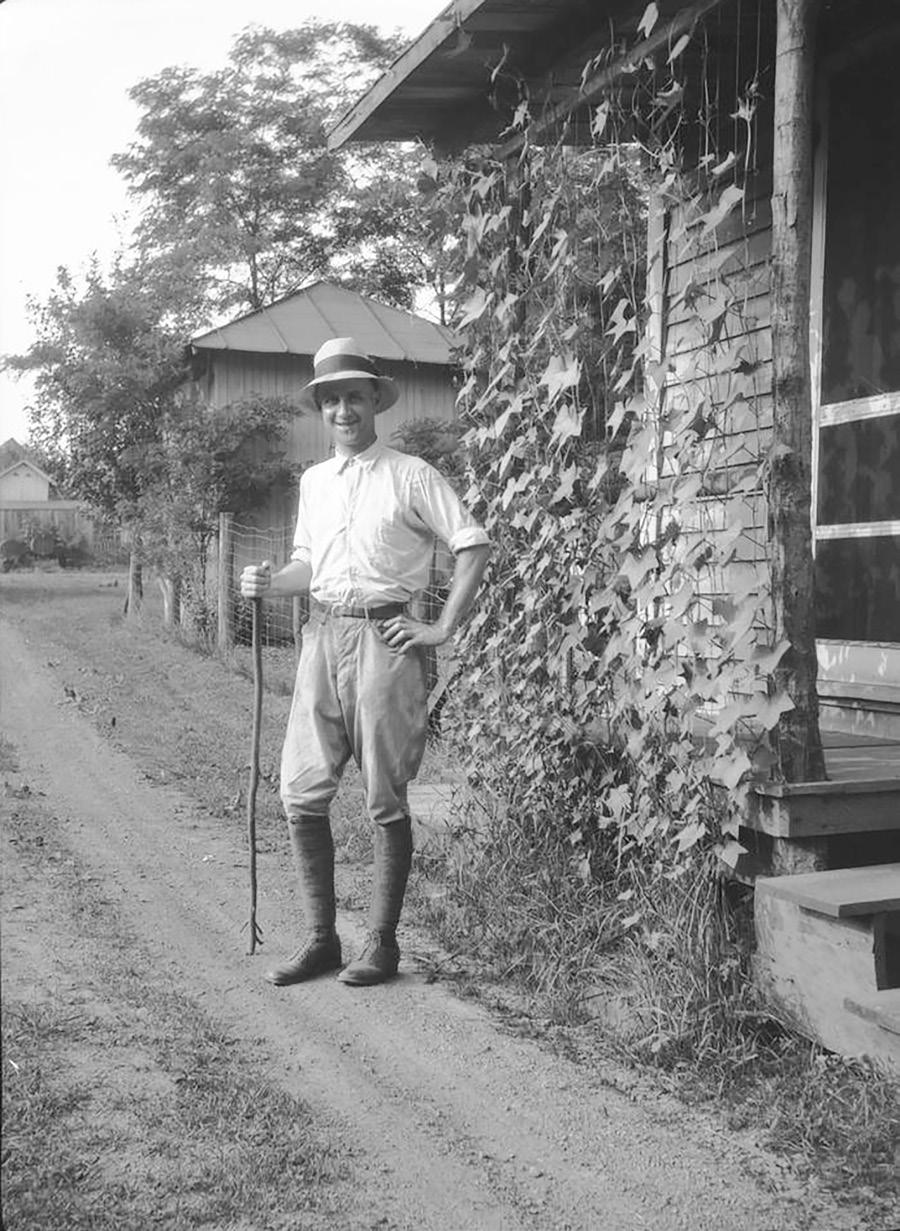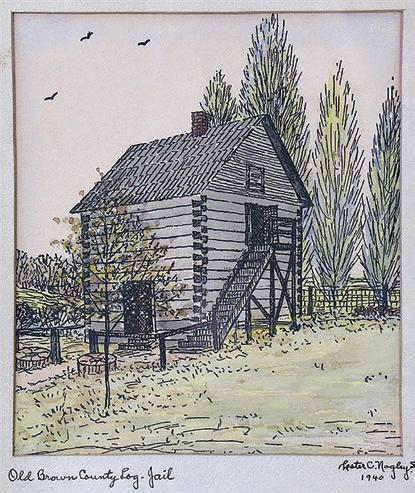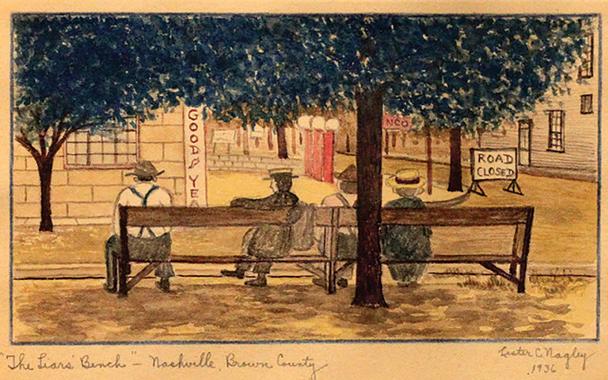
4 minute read
Lester C. Nagley
The Vagabond Artist of Brown County
~by Julia Pearson
Frank M. Hohenberger photo courtesy The Lilly Library, Indiana University, Bloomington, Indiana.
Among the contents of the Frank M. Hohenberger photograph collection in the Lilly Library is this portrait taken on a June day in 1923 at the back porch of a home in Trevlac. It is the image of Lester C. Nagley, a man of genuine smiles, friendship, and talents.
Lester Nagley was born in Greenfield, Indiana in 1889. His life spanned 75 years and was lived to the fullest following the promptings of his inborn gifts of organization, interpersonal relationship skills, service, artistic expression in several mediums, and writing.
In 1906 he moved to Indianapolis, where he began his working career in the silver-gilting trade at the H. Lieber Company picture frame plant. In 1909 he graduated from Emmerich Manual High School, where he later was an assistant teacher in the botany department for two years.
Nagley became manager of the Lieber’s photo-finishing plant, but left to work as a cub reporter on the Indianapolis Sun. He sharpened his journalistic skills as reporter, photographer, and feature writer for the Indianapolis Sun and its successor the Indianapolis Times. He continued with the Indianapolis Star in the roles of reporter, feature writer, and church editor. In 1925 he became a “publicity man” and served as a ghost writer for several politicians during their campaigns for office.
In 1935, Nagley was the leader of the Terre Haute Post of the Volunteers of America which supplied impoverished citizens with coal in the winter and with ice in the summer. Working in the oppressive summer heat led to the breakdown of his health, requiring hospitalization. In a letter written from his hospital bed to his friend, Anna Bowles Wiley who was the society page editor for the Terre Haute Tribune, Nagley confided he would seek restoration of his health in Brown County working on his art.
The following year, Nagley made his move to Brown County and claiming that he arrived with only $1.50 in his pocket. He established his first “studio” on the grounds of the county courthouse, his watercolor paintings exhibited on a display board he built from an old orange crate. When he first arrived, he roomed in the home of Fletcher Poling, but eventually made a home in Trevlac at “Sassafras Lodge.” His studio then occupied his back porch.
He found a warm circle of support with the other Brown County artists, especially Glenn Henshaw, Dale Bessire, C. Curry Bohm, and Edward K. Williams. His watercolor landscapes, etchings, and the woodcuts and linocuts that he printed on an old washing machine wringer brought him artistic recognition.


He signed his pieces, “The Vagabond Artist of Brown County.”
Exhibitions of his work were held in the home of pioneer Brown County farm dealers, Mr. and Mrs. John Kirtz; the community building that is the old log museum in the present-day Pioneer Village; the Hotel Washington; and shows in Greenfield and Terre Haute. One of his paintings was purchased by Indiana Attorney General Omer Stokes.
Nagley worked on his own publicity and was a photographer as well. In 1942 he was elected Justice of the Peace at Trevlac in Jackson Township. He spent fifteen years writing essays that were compiled into a book entitled, Interviewing God.
As a columnist he wrote “Hoosier Vignettes” for the Greenfield Daily Reporter, and “On the Liar’s Bench in Brown County” for the Hancock County Democrat. This spread the news of the tranquil natural beauty awaiting his readers at the end of a car ride to Brown County. It also interested many Indianapolis folk in excursions by the Illinois Central Railroad, completed in 1907, in the special rates to Helmsburg, amplifying the tourist industry of Brown County.
With his Indianapolis connections and people skills, Nagley is credited in 1943 as leading a Sunday art-buying expedition of A. C. B. Shafer of Indianapolis to purchasing the highest number of paintings by an individual in the Brown County Art Colony: several of Nagley’s own watercolors, a pastel painting done by Henshaw, a spring study and autumn landscape by Bessire, a small oil painting from Bohm, and three paintings from Williams.
Many of his early photographs were displayed in a photo-feature during the Indiana Sesquicentennial in the Indianapolis Star Sunday Magazine entitled “Do You Remember.” He has the noted distinction of taking the first color photograph in Indiana in April, 1915. He is also credited with taking the first synchronized flash picture of President Woodrow Wilson at Union Station in Indianapolis in 1917. Nagley took the last photograph of James Whitcomb Riley, “The Children’s Hour.”
Lester Nagley and his wife, Alvenia, had three children: sons Lester, Jr. and William; and daughter, Betty Lou. When he died in February, 1967, in Community Hospital, Indianapolis, Nagley left behind six grandchildren and one great-grandchild along with his many friends in the Masonic Lodge, Broad Ripple Methodist Church, and the Indianapolis Press Club.







